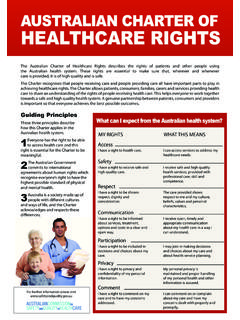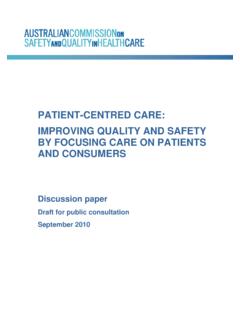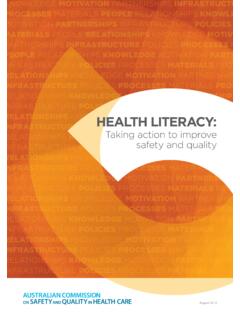Transcription of National Standard for User-applied Labelling of Injectable ...
1 National Standard for User-applied Labelling of Injectable Medicines, Fluids and Lines Commonwealth of Australia 2015 This work is copyright. It may be reproduced in whole or in part for study or training purposes subject to the inclusion of an acknowledgement of the source. Requests and inquiries concerning reproduction and rights for purposes other than those indicated above require the written permission of the Australian Commission on Safety and Quality in Health Care, GPO Box 5480, Sydney, NSW 2001 or 978-1-925224-17-7 (print), 978-1-925224-18-4 (online) suggested citation Australian Commission on Safety and Quality in Health Care. National Standard for User-applied Labelling of Injectable Medicines, Fluids and Lines. Sydney: ACSQHC, Many individuals and organisations have freely given their time and expertise to support the development of this document.
2 In particular, the Commission wishes to acknowledge state and territory contacts who have coordinated implementation, and health services that have fed back implementation experiences, which are reflected in this document. The involvement and willingness of all concerned to share their experience and expertise are greatly National Standard for User-applied Labelling of Injectable Medicines, Fluids and Lines ( Labelling Standard ) and support materials are available on the Commission web site at Labelling Standard supersedes the National Recommendations for User-applied Labelling of Injectable Medicines, Fluids and Lines, first edition (August 2010) and second edition (February 2012). National Standard for User-applied Labelling of Injectable Medicines, Fluids and LinesNational Standard for User-applied Labelling of Injectable Medicines, Fluids and LinesiiiAcronyms and abbreviations.
3 ViExecutive summary ..11 Introduction .. Administration errors with Injectable medicines .. Administration errors in the perioperative area .. Support for safe Labelling practices .. Standardisation and colour coding of medicine labels .. National Safety and Quality Health Service Standards .. National Medicines Policy .. Labelling Standard context .. Labelling Standard structure ..62 Scope of the Labelling Standard .. Inclusions .. Exclusions ..83 General requirements for Labelling .. Governance .. Properties of labels .. Label quality .. Label adhesive .. Label readability .. Preprinted labels .. Colour coding .. Route of administration .. Medicine class ..114 Labelling Injectable medicine containers .. General considerations for all containers .. Fluid bags.
4 Syringes .. Containers in open- and closed -practice environments .. When to discard containers of Injectable medicines .. Minimum requirements for Labelling containers in the open-practice environment .. Minimum requirements for Labelling containers in the closed -practice environment .. Injectable medicines .. Non- Injectable medicines and fluids ..19 CONTENTSA ustralian Commission on Safety and Quality in Health Careiv5 Labelling Injectable medicine conduits, lines and catheters .. Burettes .. Minimum requirements for Labelling Administration lines .. Administration lines and catheters to identify route .. Administration lines to identify medicine .. Label placement for administration lines .. Invasive monitoring lines .. Minimum requirements for Labelling invasive monitoring lines.
5 Locked catheters .. Minimum requirements for Labelling locked catheters .. Other catheters and lines .. Pulmonary artery catheters .. Intracranial pressure monitoring lines .. Extraventricular and lumbar drains .. Bladder irrigation lines ..246 Labelling in perioperative areas .. Open- and closed -practice Containers on perioperative sterile fields .. Interventional cardiology, radiology and other low-light procedure areas .. Contrast media .. Reusable containers .. Using preprinted labels ..307 Specific considerations .. Containers and lines on sterile fields outside the perioperative area .. Catheter lock .. Cytotoxic medicines .. Radiopharmaceuticals .. Blood products .. Non- Injectable medicines and fluids .. Oral and enteral route .. Inhalation route .. Topical route.
6 Labelling at transitions of care .. Labelling in an emergency ..33 Glossary ..34 Acknowledgements ..36 Appendix 1 Label guide and specifications ..38 Appendix 2 Specifications for preprinted abbreviated container labels ..43 Appendix 3 The Labelling Standard and other standards ..44 Appendix 4 Labelling Standard development and maintenance ..48 References ..51 National Standard for User-applied Labelling of Injectable Medicines, Fluids and LinesvTablesTable 1 Colour coding of User-applied labels for target tissue ..11 Table 2 User-applied label colours for syringes containing medicines used during anaesthesia (adapted from ISO 26825:2008) ..12 Table 3 Examples of preprinted medicine line labels ..14 Table Modifications to AS 4940 used in the Labelling Standard : background and borders.
7 45 Table Modifications to AS 4940 used in the Labelling Standard : colour for target tissue/route ..46 Table Anaesthetic Labelling Standard colour coding to medicines lines labels and abbreviated container labels used outside anaesthesia ..47 FiguresFigure 1 Examples of containers and conduits for Injectable medicines that require User-applied Labelling ..7 Figure 2 User-applied Labelling of medicines and fluids in the open- and closed -practice environments of the perioperative area ..26 Figure 3 Examples of preprinted abbreviated container labels for User-applied identification in the closed -practice environment ..27 Figure 4 Generic abbreviated container label for User-applied identification in the closed -practice environment ..28 Figure 5 Examples of preprinted labels in cardiac catheter laboratories.
8 29 Figure 6 Contrast media abbreviated container label ..30 Figure 7 Line label for medicine used to lock a catheter ..31 Figure 8 Label for enteral use ..32 Figure 9 Label for inhalation use ..33 Australian Commission on Safety and Quality in Health CareviAcronyms and abbreviationsAnaesthetic Labelling StandardInternational Standard ISO 26825:2008 Anaesthetic and respiratory equipment User-applied labels for syringes containing drugs used during anaesthesia colours, design and performanceAS 4940:2002 Australian Standard AS 4940:2002 User-applied identification labels for use on fluid bags, syringes and drug administration linesthe CommissionAustralian Commission on Safety and Quality in Health Carethe Labelling RecommendationsNational Recommendations for User-applied Labelling of Injectable Medicines, Fluids and Linesthe Labelling StandardNational Standard for User-applied Labelling of Injectable Medicines, Fluids and LinesPMSP antone Matching SystemNational Standard for User-applied Labelling of Injectable Medicines, Fluids and Lines1 Executive summaryInjectable medicines are a high-risk therapy for patients and health professionals.
9 It is reported that 25% of all medication incidents in acute care involve Injectable medicines, but nearly 60% of medication errors that result in serious patient harm or death involve Injectable medicines (1).Incomplete or inaccurate Labelling of Injectable medicines and fluids (and the devices used to deliver them) is a recognised risk to the safe administration of medicines and is potentially preventable. Improved Labelling can reduce the risk of error and harm by safely communicating the contents of Injectable medicines containers and the patients for whom they are intended (2).One way of ensuring accurate communication of Injectable medicines and fluids information is by standardised User-applied Labelling . This National Standard for User-applied Labelling of Injectable Medicines, Fluids and Lines (the Labelling Standard ) has been developed as a National solution to the risks posed by erroneous administration of Injectable medicines.
10 It replaces the 2012 National Recommendations for User-applied Labelling of Injectable Medicines, Fluids and Lines (the Labelling Recommendations) (3).AimsThe Labelling Standard is designed to reduce the risk of patient harm from Injectable medicines by helping healthcare professionals identify the correct: Injectable medicine or fluid (container) route of administration of the Injectable medicine (conduit) patient for whom the medicine is Labelling Standard sets out the requirements for label format, content and placement. The aim is to: promote safer use of Injectable medicines provide standardisation for User-applied Labelling of Injectable medicines provide minimum requirements for User-applied Labelling of Injectable Labelling Standard addresses one recognised risk point in the safe administration of Injectable medicines by preventing medicine administration errors, such as wrong patient, wrong route, wrong medicine or wrong dose.










